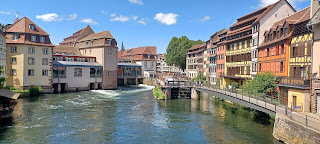We headed across the border (something you don’t even notice) to Germany. What you do notice immediately is that people drive fast, really fast (there truly is no speed limit on the famous German Autobahn). Why did we choose this area to explore? Because it was easy to get to, has famous spas, and is quite scenic.
Baden Baden is an upscale town that has been a spa resort since the 19th century. Our time at Friedrichsbad, the Roman-Irish Bath, which opened in 1877, was a highlight of the trip. It is a naked, co-ed spa. Cori and David are close friends, and now they are even closer.
At the spa you pass through various stations, starting with dry heat, transitioning to wet heat – getting hotter in each place – then transitioning to soak in various pools that gradually get cooler, including the ultimate cold plunge. After drying off with warm towels and moisturizing with lotion, you get wrapped up like a burrito and nap/relax in a quiet room, before lounging with a cup of tea. It was fabulous! So fabulous we went back again the next day.
We explored the town sights, observing the quiet elegance, and hiked up to a biergarten for dinner. After dinner schnapps were included.
We enjoyed some outdoor time in the Black Forest, which has lots of pleasant trails. We did three short hikes as stops along the High Road drive. One hike was along a river to a waterfall, another was a walk around Mummelsee lake, and the last was the Lothar Trail, which is an area hit by a hurricane in 1999 that has been allowed to recover naturally.
Our final day with Cori and David was spent in Heidelberg, our first and only experience with very large crowds in Germany. Heidelberg has a charming old town and a semi-restored Renaissance castle. It was a hot day, and we sweated our way up to visit the castle, which provided great views.
We had a lot of laughs during our time with Cori and David. It is always amazing to reconnect and seemingly pick up where you left off with long-time friends that you haven’t seen for far too long. As they headed home to pick their kids up from camp, we continued our journey to visit the Rhine and Mosel valleys.
More soon,
Shana & Jeff






































